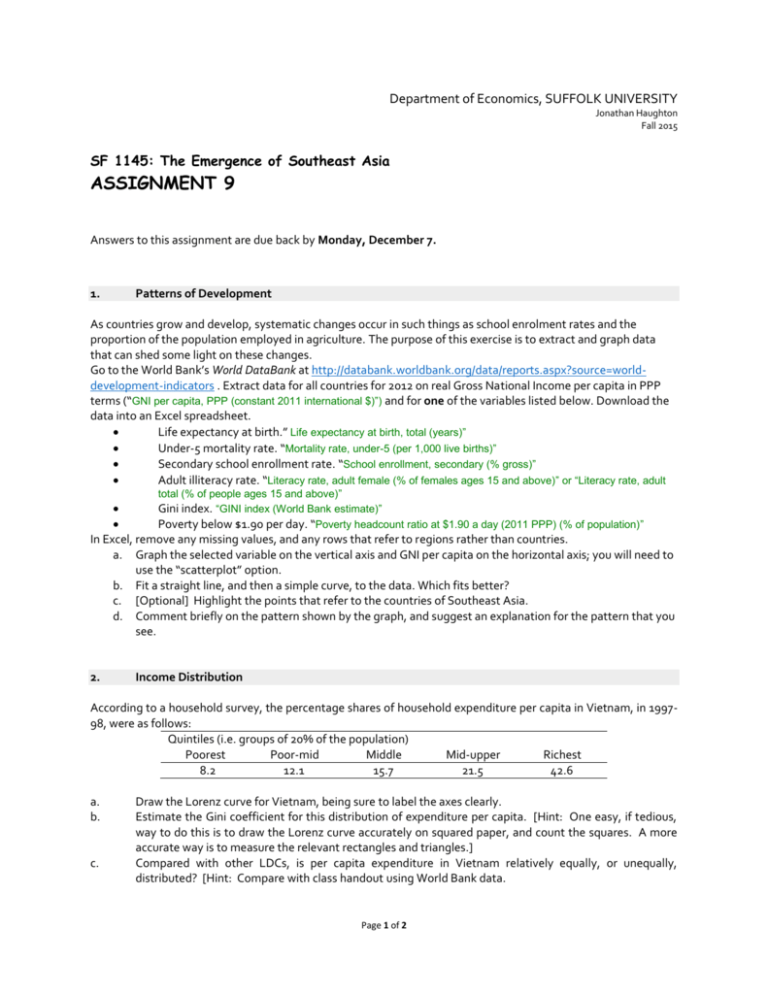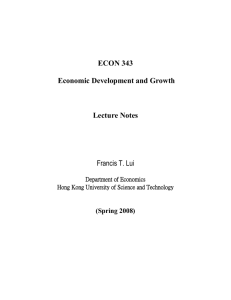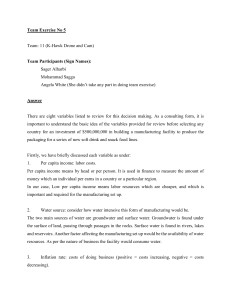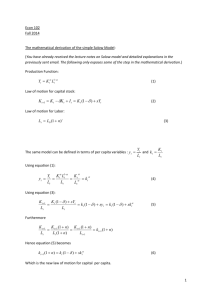PS 9 - Suffolk University
advertisement

Department of Economics, SUFFOLK UNIVERSITY Jonathan Haughton Fall 2015 SF 1145: The Emergence of Southeast Asia ASSIGNMENT 9 Answers to this assignment are due back by Monday, December 7. 1. Patterns of Development As countries grow and develop, systematic changes occur in such things as school enrolment rates and the proportion of the population employed in agriculture. The purpose of this exercise is to extract and graph data that can shed some light on these changes. Go to the World Bank’s World DataBank at http://databank.worldbank.org/data/reports.aspx?source=worlddevelopment-indicators . Extract data for all countries for 2012 on real Gross National Income per capita in PPP terms (“GNI per capita, PPP (constant 2011 international $)”) and for one of the variables listed below. Download the data into an Excel spreadsheet. Life expectancy at birth.” Life expectancy at birth, total (years)” Under-5 mortality rate. “Mortality rate, under-5 (per 1,000 live births)” Secondary school enrollment rate. “School enrollment, secondary (% gross)” Adult illiteracy rate. “Literacy rate, adult female (% of females ages 15 and above)” or “Literacy rate, adult total (% of people ages 15 and above)” Gini index. “GINI index (World Bank estimate)” Poverty below $1.90 per day. “Poverty headcount ratio at $1.90 a day (2011 PPP) (% of population)” In Excel, remove any missing values, and any rows that refer to regions rather than countries. a. Graph the selected variable on the vertical axis and GNI per capita on the horizontal axis; you will need to use the “scatterplot” option. b. Fit a straight line, and then a simple curve, to the data. Which fits better? c. [Optional] Highlight the points that refer to the countries of Southeast Asia. d. Comment briefly on the pattern shown by the graph, and suggest an explanation for the pattern that you see. 2. Income Distribution According to a household survey, the percentage shares of household expenditure per capita in Vietnam, in 199798, were as follows: Quintiles (i.e. groups of 20% of the population) Poorest Poor-mid Middle Mid-upper Richest 8.2 12.1 15.7 21.5 42.6 a. b. c. Draw the Lorenz curve for Vietnam, being sure to label the axes clearly. Estimate the Gini coefficient for this distribution of expenditure per capita. [Hint: One easy, if tedious, way to do this is to draw the Lorenz curve accurately on squared paper, and count the squares. A more accurate way is to measure the relevant rectangles and triangles.] Compared with other LDCs, is per capita expenditure in Vietnam relatively equally, or unequally, distributed? [Hint: Compare with class handout using World Bank data. Page 1 of 2 3. World Bank Loans The World Bank is able to make only a limited amount of subsidized loans. Assume that it can only provide cheap loans to three of the following countries: Myanmar, Cambodia, Philippines, Vietnam, Laos. You have been asked to recommend the three countries that "are most in need of subsidized finance, and most able to put it to good use." Which three countries would you recommend, and why? [Hint: The data from the World Development Report may help guide your answer.] Page 2 of 2











